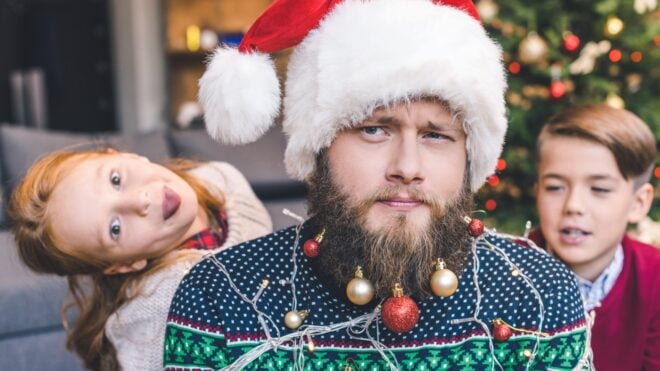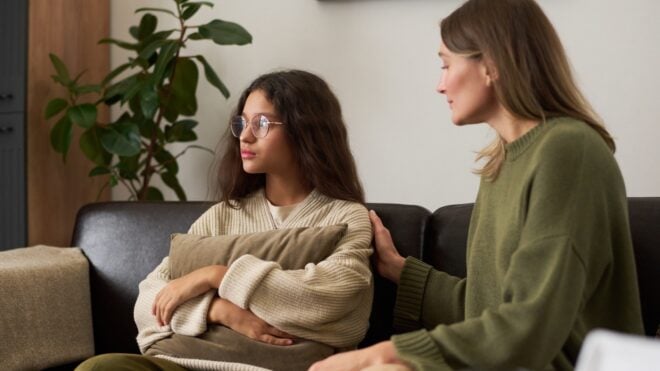A Paws-itive Fix

To protect your window sills or doors from paw prints and claw marks, look into the brand Sill Shield. Invented by a dog owner who needed a long-term fix for his paw-printed windowsills, the plastic coverings are available in a variety of sizes to fit any window or door and can be attached and removed easily, no tools required.
Love This? Follow us on Pinterest.
Image via Twenty20/arni_stalnoy_oreh
Scratch That

If clawed-up furniture or curtains become an issue, consider trying a product like Soft Claws instead of declawing your pet. The nail caps blunt the claws so that no damage can occur when cats or dogs scratch at an area of your house. Not only will these caps protect your furniture, Soft Claws promises to protect you or anyone in your home against accidental scratches as well.
Love This? Follow us on Pinterest.
Image via Twenty20/astova
Damage Control

For pets that get easily excited when guests arrive (and then pee to show their excitement), Hope Saidel, president of the North Shore Dog Training Club in the Chicago area and co-owner of GollyGear.com, recommends trying Belly Bands. The bands stretch over the backside of your dog's waist with Velcro and act as a diaper of sorts to prevent any bathroom accidents. While it's not to be used in lieu of house training, it can at least give you peace of mind when guests are visiting.
Love This? Follow us on Pinterest.
Image via Twenty20/alibubbalicious
Crates Are Great

Crate training is by far the best solution to both prevent accidents and also protect dogs from inadvertently harming themselves. As Katt Hudson, a pet care specialist with Gold Star Pet Services, says, even leaving them unsupervised while you take a 10-minute shower is enough time for them to do damage. In her experience, she returned to find her dog chewing a bottle of Tylenol. Remember: The crate is for their good as much as for your home.
Love This? Follow us on Pinterest.
Image via Twenty20/towen
Stove Steppin'

To prevent cats from jumping up to the stove area and gambling yet another one of their nine lives, an easy solution is to place aluminum foil over the stovetops, suggests Hudson. Cats don't like the feel of stepping on the foil, so chances are they'll stop jumping up there, which is a good thing if you'd rather not make an emergency trip to the vet when you should be making dinner.
Love This? Follow us on Pinterest.
Image via Twenty20/tcatandy
Household Harm

Another prevention tip: Be on the lookout for items around your house or in the yard that are toxic and potentially fatal if ingested by pets, says Dr. Kerri Marshall, the Chief Veterinary Officer for Trupanion Pet Insurance. While you're probably already aware that chocolate is a big no-no, a few other things to have on your radar include raisins, lilies, tulips, azaleas, fertilizer, pest control substances, household cleaning products, hand sanitizer and inhalers.
Image via Twenty20/tvalentine528
Smaller Spaces

For bathroom or behavioral issues involving cats, one factor that might be contributing to the problem is too much space. According to Jme Thomas, executive director of Motley Zoo Animal Rescue, cats (especially cats new to a home) prefer smaller spaces opposed to large rooms, so keep their litter box and food/water in one room at first. When you're not at home, they should be confined to that room as well. You can then expand their space over a few weeks under your supervision, which will give them time to acclimate to their new territory and not feel overwhelmed.
Love This? Follow us on Pinterest.
Image via Twenty20/bjoymc
Pee Problems

For pets that continually pee in the same area, tape a potty pad over the spot, says Thomas. While it's not a permanent solution, it will at least save you some frustration in the meantime. Also, make sure to clean the area with an enzyme solution since pets tend to do their business in the same places they've gone before. When house-training dogs, Thomas suggests taking them outside on a leash every time and watching them go to the bathroom since some dogs will fake it, especially if it's raining.
Love This? Follow us on Pinterest.
Image via Twenty20/johnpoveromo
Pee Problems, Part 2

While we're on the subject of house-training, learning how to train your pets properly is key. If your dog goes to the bathroom in the house and you're not there to witness it, scolding after the fact will do no good. In fact, it's similar to a toddler having an accident — sometimes, it just happens. And it's up to the owner to find the cues and prevent accidents, just as parents do with their toddlers, says Thomas.
A few tips to streamline this process: Never leave the dog unattended, especially if it's a puppy. Close doors or use baby gates to keep dogs away from carpet and make use of that crate. If the dog doesn't pee outside, put him in the crate for a short period of time and then take him outside again. Repeat as necessary. "The confines of the crate physically provide cues telling them, 'Don't go in here,' and can really help them learn to develop their bladders and good habits," says Thomas.
Love This? Follow us on Pinterest.
Image via Twenty20/alimyers7
Medical Attention

If your pet isn't getting the hang of house training, it maybe a sign of a bigger underlying issue, says Thomas. Many times, a urinary tract infection could be the culprit of incontinence. Always make an appointment with the vet if you're having trouble with house training before doing anything drastic, such as giving up the pet.
Love This? Follow us on Pinterest.
Image via Twenty20/girl_with_far_away_eyes




